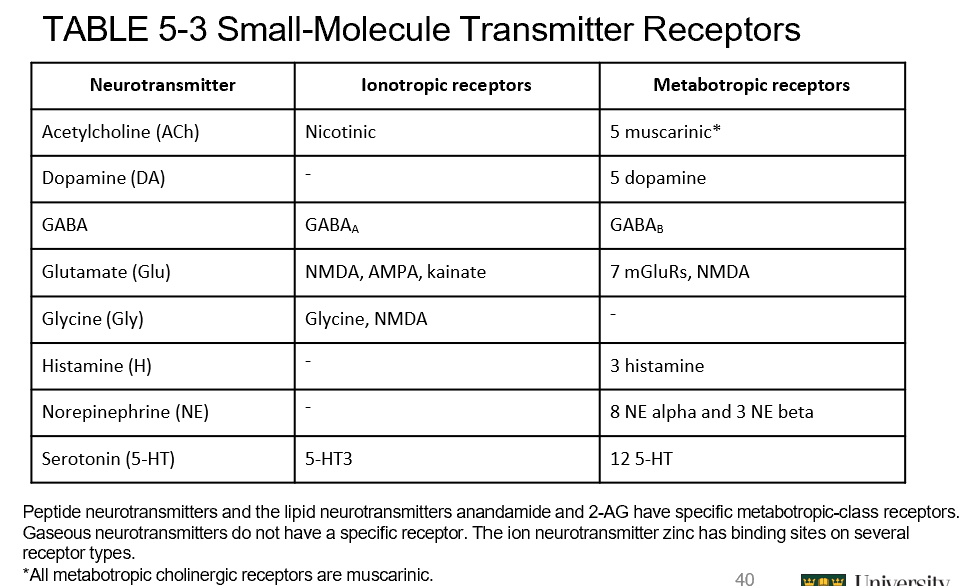5. + 6. Neural communication Pt 2 - Neuronal learning
1/143
Earn XP
Description and Tags
Chapter 5
Name | Mastery | Learn | Test | Matching | Spaced |
|---|
No study sessions yet.
144 Terms
Neurotransmitters
___________ - chemical with an excitatory or inhibitory effect when released by a neuron onto a target— sent over synapses
Outside the nervous system, like in the bloodstream, these are considered hormones
A __________itself is NOT what determines inhibitory and exhibitory EFFECT.
The inhibitory or excitatory effect depends on the receptor site for it on the target.
Hormones
____________ - chemical that circulates in the bloodstream outside the CNS— much slower than neurotransmitters
Controlled by the hypothalamus
Uses bloodstream to impact organs throughout body
In the CNS, these are considered neurotransmitters
Neuron communication
_____________- occurs across the synapse and is largely chemical, spurred by electrical action potentials.
Synapse
Acetycholine (ACh)
Neurotransmitters (chemicals)
______________ - anything we need to move— activates skeletal muscles in the SNS and either excites or inhibits internal organs in the ANS
First neurotransmitter discovered in the PNS and CNS by Otto Loewi
The chemical messenger that is associated with slowed heartbeat in diving bradycardia (a protective physiological reflex where the heart rate slows significantly when a person holds their breath and submerges their face in water)
Epinephrine (EP)
Neurotransmitters (chemicals)
______________ - acts as a neurotransmitter in CNS + hormone to mobilize the body in fight or flight
AKA adrenaline
Norepinephrine (NE)
Neurotransmitters (chemicals)
______________ - accelerates heart rate in mammals— found in the brain and sypathetic (fight or flight) division of the ANS
AKA noreadrenaline
Parkinson’s disease
Neurotransmitters (chemicals - dopamine) + CNS’ 4 activating systems (Cho, Dope, Nora, Sero) → nigrostriatal pathways
____________ - disorder of the motor system correlated w/ a loss of dopamine from the substantia nigra
Characterized by: tremors, muscle rigidity, reduction of voluntary movement
Less dopamine by about 10% in the basal ganglia
Dopamine (DA)
Neurotransmitters (chemicals)
______________ - amine neurotransmitter involved w/ coordinating movement, attention, learning, and reinforcing behaviours
Parkinson’s disease
Synaptic vesicles
Structure of synapses (chemical synapses)
___________ - membranous compartment that encloses a fixed number (AKA a quantum) of neurotransmitter molecules
A round granule that contains neurotransmitters

Structure of synapses
Synapse
___________ - contains multiple parts:
Synaptic vesicles
Microtubule
Mitochondion
Storage granule
Presynaptic membrane
Synaptic cleft
Postsynaptic membrane
Postsynaptic receptor
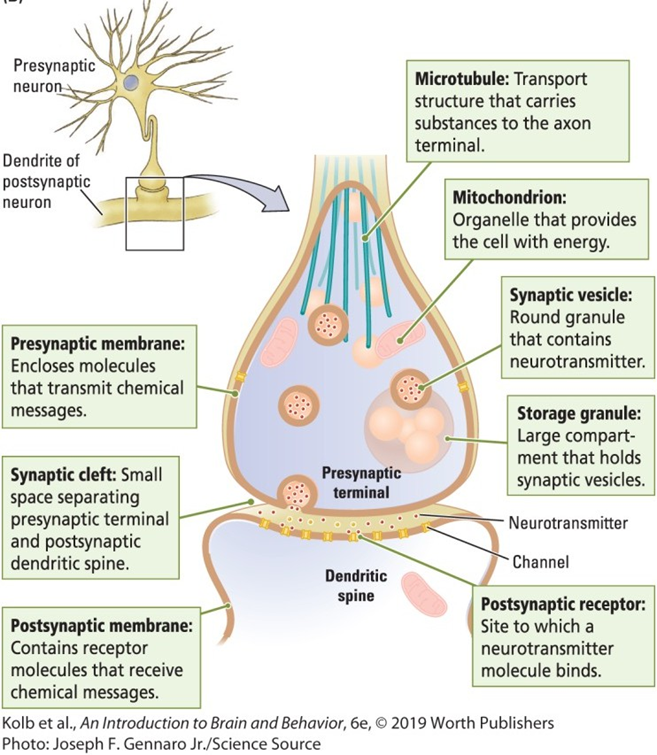
Synapse
__________ - spatial junction between one neuron and another— forms the info transfer site between neurons.
Structure of synapse
Chemical synapse
Types of synaptic transmission (anterograde, retrograde)
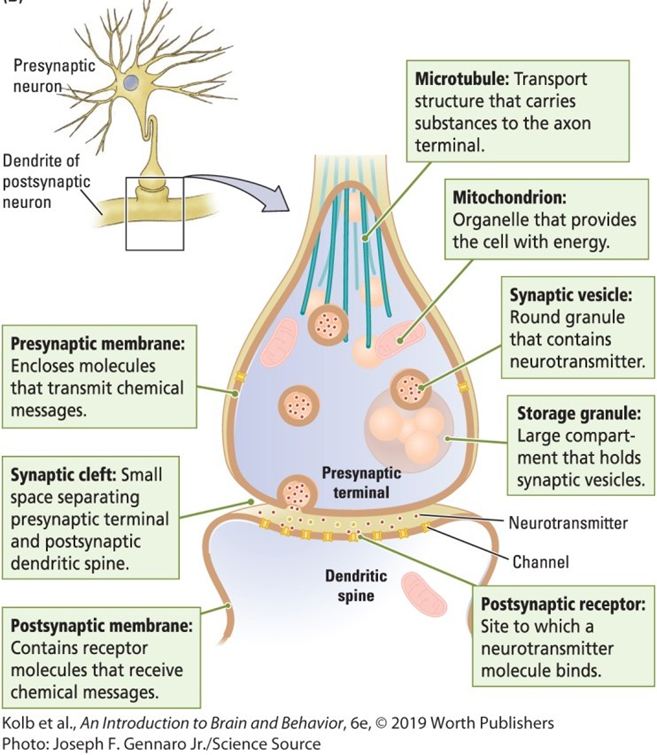
Microtubule
Structure of synapses (chemical synapses)
___________ - transport molecule that carries substances to the axon terminal

Mitochondrion
Structure of synapses (chemical synapses)
___________ - organelle that provides cell w/ energy

Storage granule
Structure of synapses (chemical synapses)
___________ - large compartment that holds synaptic vesicles, containing neurotransmitters
On the presynaptic side

Postsynaptic receptor
Structure of synapses (chemical synapses)
___________ - site to which a neurotransmitter molecule binds
On the postsynaptic side

Postsynaptic membrane (dendritic spine)
Structure of synapses (chemical synapses)
___________ - contains receptor molecules that recieve chemical messages
Once a neurotransmitter is expelled into the synaptic cleft and crosses it, it binds to receptor proteins here in the _________.

Synaptic cleft
Structure of synapses (chemical synapses)
___________ - small space seperating presynaptic terminal and postsynaptic dendritic spine
Neurotransmitter expels into here by exocytosis, leading it to bind to the postsynaptic membrane
AKA space between axon terminal and dendritic spine

Presynaptic membrane (axon terminal)
Structure of synapses (chemical synapses)
___________ - encloses molecules that transmit chemical messages
After being released by the storage granule, vesicles w/ neurotransmitters in them travel here for release

Exocytosis
Structure of synapses (chemical synapses)
___________ - this is how a neurotransmitter gets from the presynaptic membrane to the synaptic cleft— process where a cell releases large molecules out of the cell by having it fuse with the plasma membrane
Tripartite synapse
Structure of synapses (chemical synapses)
___________ - functional integreation + physical proximity of the presynaptic membrane, postsynaptic membrane, and their intimate association w/ surrounding astrocytes
Integration + closeness of the axon terminal and dendritic spine, and their association w/ surrounding astrocytes
Dendritic spine
Structure of synapses (chemical synapses)
___________ - The postsynaptic membrane is also known as…
Axon terminal
Structure of synapses (chemical synapses)
___________ - The presynaptic membrane is also known as…
space between the axon terminal + dendritic spine
Structure of synapses (chemical synapses)
___________ - The synaptic cleft is also known as the….
Chemical synapse
Synapse
___________ - junction at which messenger molecules are released when
Diagram explains it

Anterograde synaptic transmission
_____________- process that occurs when a neurotransmitter is released from a presynaptic neuron and binds to a receptor on the postsynaptic neuron
(From the axon terminal to the dendritic spine)
Five easy steps!
Like a recipe, doing it step-by-step- is a precise science— if you don’t do it right the first time, it won’t come out right
Five easy steps to anterograde synaptic transmission
Anterograde synaptic transmission
_____________ - five steps which include…
Neurotransmitter is synthesized somewhere inside the neuron
It is packaged + stored within vesicles at the axon terminal (presynaptic membrane)
It’s transported to the presynaptic membrane + released into the cleft in response to an action potential
It binds to + activates receptors on the postsynaptic membrane (dendritic spine)
It is degraded or removed so it doesn’t continue to interact w/ a receptor and work indefinitely.
Step 1) Neurotransmitter is synthesized somewhere in neuron
Anterograde synaptic transmission (5 easy steps)
_______________ - done in two general ways— either synthesizes in the axon terminal or cell body:
Axon terminal: building blocks from food are pumped into the cell via transporters, embedding protein molecules in cell membrane
Cell body: according to instructions in DNA for peptide transmitters, while transported on microtubules to axon terminal
Transporters
Anterograde synaptic transmission (5 easy steps) → step 1+ 2: synthesis, packaging + storage
_______________ - protein molecules that pump substances across a membrane— responsible for packaging some neurotransmitter classes into vesicles
Step 2) Neurotransmitter is packaging + storage
Anterograde synaptic transmission (5 easy steps)
_______________ - neurotransmitter is packaged + stored within vesicles at the axon terminal (presynaptic membrane)— packaged in 3 ways:
Granules
Attatched to microfilaments
Attached to presynaptic membrane
Step 3) Neurotransmitter is released
Anterograde synaptic transmission (5 easy steps)
_______________ - Neurotransmitter is transported to the presynaptic membrane + released into the cleft in response to an action potential— like a key in a lock.
At the terminal, the action potential opens voltage-sensitive calcium (Ca2+) channels
Ca2+ enters the terminal and binds to the protein calmodulin, forming a complex.
The complex causes some vesicles to empty their contents into the synapse and others to get ready to empty their contents.
Neurotransmitter find their specific receptors on the postsynaptic side, where binding sites activate the neurotransmitter

Step 4) Receptor-site activation
Anterograde synaptic transmission (5 easy steps)
_______________ - After release, the neurotransmitter diffuses across the synaptic cleft to activate receptors on the postsynaptic membrane
On postsynaptic side, three things can happen: EPSPs, IPSPs, or other chemical reactions.
Transmitter-activated receptors
Ionotropic receptors
Metabotropic receptors
Autoreceptors
Quantum (pl. quanta)
EPSPs
Anterograde synaptic transmission (5 easy steps) → step 4: receptor-site activation
_______________ - on postsynaptic side, an excitatory action or depolatrization of the postsynaptic membrane can happen
IPSPs
Anterograde synaptic transmission (5 easy steps) → step 4: receptor-site activation
_______________ - on postsynaptic side, an inhibiatory action or hyperpolarization of the postsynaptic membrane can happen
Transmitter-activated receptors
Anterograde synaptic transmission (5 easy steps) → step 4: receptor-site activation
_______________ - protein that has a binding site for a specific neurotransmitter and is embedded in the cell membrane
Ionotrophic receptors
Anterograde synaptic transmission (5 easy steps) → step 4: receptor-site activation
_______________ - embedded membrane protein— acts as a binding site for a neurotransmitter AND a pore that regulates ion flow to directly + rapidly change membrane voltage
Associated w/ a pore that can open to allow ions to pass through it— two ways:
Allowing Na+ to enter = depolarization → leads to an excitatory effect on postsynaptic membrane
Allow K+ to leave neuron, or Cl- to enter = hyperpolarization → leads to inhibatory effect on postsynaptic membrane
Metabotrophic receptor
Anterograde synaptic transmission (5 easy steps) → step 4: receptor-site activation
_______________ - embedded membrane protein w/ a binding site for a neurotransmitter linked to a G protein— can affect other receptors or act w/ second messangers to affect other cellular processes, like opening a pore
Autoreceptors
Anterograde synaptic transmission (5 easy steps) → step 4: receptor-site activation
_______________ - AKA self-receptors — responds to the same transmitter released by the neuron. Part of negative feedback loop allowing neuron to adjust its output
Serve critical function for this loop, provides info about adjustments to synaptic communication
Can fo in a loop from presynaptic to postsynaptic— have a modulatory role.
Quantum (pl. quanta)
Anterograde synaptic transmission (5 easy steps) → step 4: receptor-site activation
_______________ - no. of neurotransmitter molecules— equivalent to the content of a SINGLE synaptic vesicle— that provides a just-observable change in postsynaptic electric potential
Producing a postsynaptic potential large enough to cause a postsynaptic action potential needs the simulatenous release of MANY ______ from the presynaptic cell
No. of_____ in response to an AP depends on:
1) Amount of Ca+ that enters axon terminal in response to AP
2) No. of vesicles docked @ membrane, waiting to be released
Step 5) Neurotransmitter inactivation
Anterograde synaptic transmission (5 easy steps)
_______________ - neurotransmitter needs to end to not occupy other messahes— this flexibility is needed to allow the synapse to respond to the frequency of its own use.
Four ways: Double' D’s Re-Up!!!!!!
Diffusion
Degradation
Reuptake
Astrocyte reuptake
Diffusion, degradation, reuptake, astrocyte uptake (Double D’s Re-Up)
Anterograde synaptic transmission (5 easy steps) → step 5: inactivation
_______________ - 4 ways of anterograde synaptic transmission — inactivation are…
Name the four ways and the weird acronym
1) Diffusion
Anterograde synaptic transmission (5 easy steps) → step 5: inactivation (Double D’s Re-Up!!)
_______________ - some of the neurotransmitter simply diffuses away from the cleft and is no longer available to bind to receptors
Cannot bind after this
2) Degradation
Anterograde synaptic transmission (5 easy steps) → step 5: inactivation (Double D’s Re-Up!!)
_______________ - enzymes in synaptic cleft break down the neurotransmitter
If it doesn’t diffuse on its own, an enzyme breaks it down so it no longer has the same structure and therefore, can’t bind
3) Reuptake
Anterograde synaptic transmission (5 easy steps) → step 5: inactivation (Double D’s Re-Up!!)
_______________ - transmitter is brought back into the presynaptic axon terminal— RECYCLE
By-products of degradation can also be recycled
4) Astrocyte reuptake
Anterograde synaptic transmission (5 easy steps) → step 5: inactivation (Double D’s Re-Up!!)
_______________ - nearby astrocytes take up the neurotransmitter, and can also store these transmitters for re-export to the axon terminal— repurpose them
Varieties of synapses
Synapse
___________ - anterograde synaptic transmission are genertic chemical synapses, but there is more diversity as synapses vary widely in the nervous system, specializing in specific locations, structurs, functions, and targets
Wide connections make synapses = versatile
7 types

Dendrodentritic
Varieties of synapses
____________ - dendrites send messages to other dendrites

Axodendritic
Varieties of synapses
____________ - Axon terminal of one neuron synapses on dendritic spine of another

Axoextracellular
Varieties of synapses
____________ - terminal with no specific target– secretes transmitter into extracellular fluid

Axosomatic
Varieties of synapses
____________ - axon terminal ends on cell body
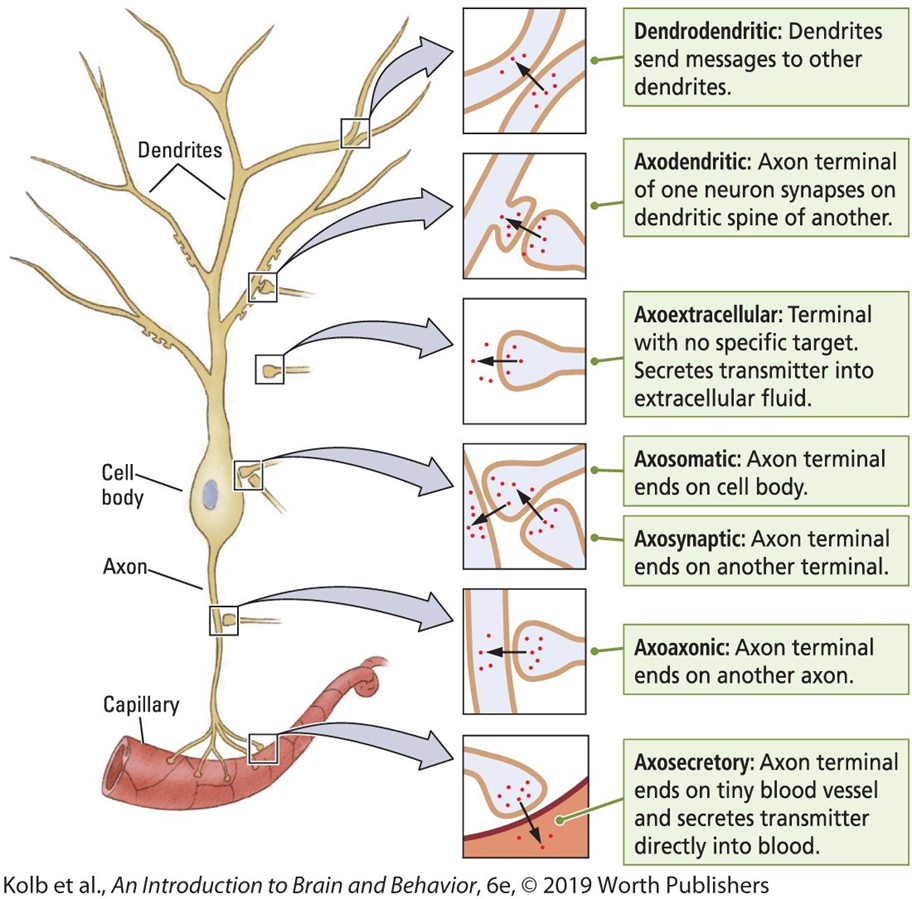
Axosynaptic
Varieties of synapses
____________ - axon terminal ends on another terminal
Synapses can exert precise control over another neurons input to a cell

Axoaxonic
Varieties of synapses
____________ - Axon terminal ends on another axon

Axosecretory
Varieties of synapses
____________ - axon terminal ends on tiny blood vessels and secretes transmitter directly into blood

Electrical synapses/gap junction
Synapse
____________ - Very fast. Fused presynaptic and postsynaptic membrane that allows an action potential to pass directly from one neuron to the next
___________ is found in interneurons to exchange certain substances between neurons and glial cells, or synchronize their behaviour
Area of contact between adjacent cells where connexin proteins in each cell form connection hemichannels, that when open, allow ions to pass thru the two cells.
A diff way of getting messages cell to cell— this is why crayfish flick their tail so efficiently
While chemical synapses are most common, these are another type…
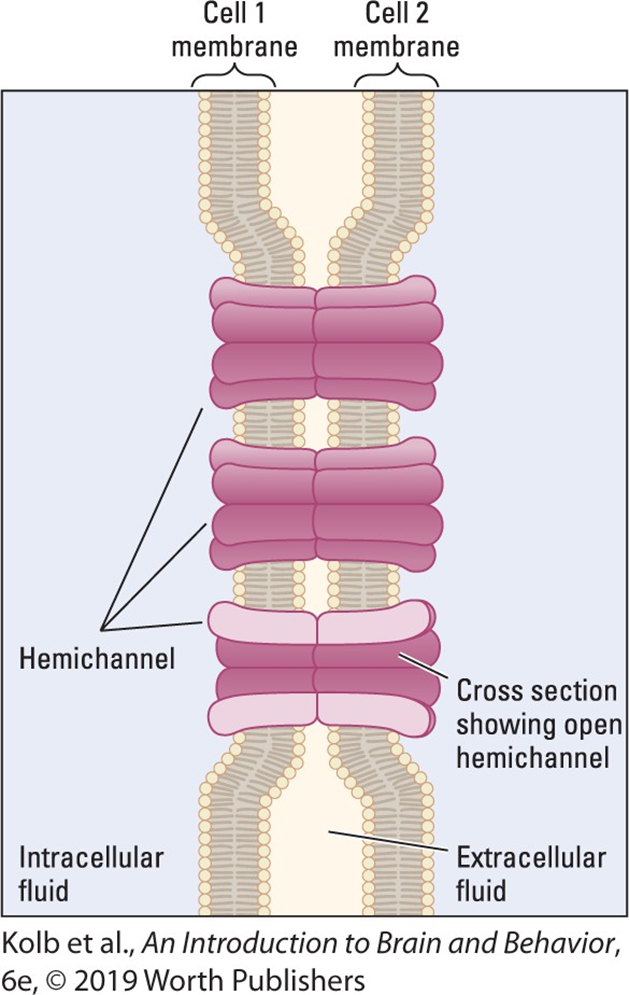
Excitatory synapse
Synapse
____________ - Makes neuron MORE LIKELY to fire an AP— usually located on dendrites. Round vesicles, dense material on membranes, wide cleft— large active zone (receptors cover more area)
If enough inhibition, the axon hillock can stop the flow – if net excitatory and inhibition doesn’t stop the AP, then it’s a go.
“Open the gate” strat = excitation NEEDS inhibition to lift, to allow neuron to fire
Like a racehorse ready to run the track, the inhibatory starting gate must be removed

Inhibitory synapse
Synapse
____________ - Makes neuron LESS LIKELY to fire an AP— usually located on cell body— flat vesicles, sparse material on membrane, narrow cleft, smaller active zone (receptors cover sparse area)
Closer to where the APs start (soma or axon hillock)
“Cut em off at the pass” start = inhibition stops excitation at the soma — blocking signal early
Better to stop it at the soma close to the initial segment/axon hillock

Chemical vs electrical synapses
Synapse
_____________ - some major differences:
Chemical synapse: relied on more— more flexible and show plasticity (learning)
Can amplify or diminish signal sent form one neuron to the next
can change with experience to alter signals AKA, LEARN
Electrical synapse: less relied on due to no plasticity, but way quicker
Don’t show plasticity, but build for speed + efficient communication
Evolution of complex neurotransmission systems
____________ - Chemical transmission may have had its origins in the feeding behavior of single-celled creatures
Digestive juices are secreted onto prey via exocytosis (release of neurotransmitter)
Prey is captured via endocytosis
This process parallels the use of neurotransmitters for communication
chemical synapses; gap junction/electrical synapses
5-1 Review Questions
In mammals, the principal form of communcation between neurons occurs via _________, even though this structure is slower and more complex than the fused ________.
experience; learning
5-1 Review Questions
The principal benefit of chemical synapses over electrical synapses is that they can change with__________ to alter their signals and therefore, mediate (show) __________.
dendrite; cell body/soma
5-1 Review Questions
Excitatory synapses are usually lcoated on a(n) ____________, while inhibatory synapses are usually located on a(n) ___________.
4 criteria for identifying neurotransmitters
____________ - are used to figure out “hey this chemical might be a neurotransmitter!”
Transmitter must be synthesized or present in neuron
When released, transmitter must produce a response in target cell (essentially it must have a job (exhibitory, inhibitory, or signal to proteins)
Same receptor action must be obtained when transmitter is experimentally placed on receptor– you can replicate that job/action/response in an artificial way or elicit the same response on the receptor side
There must be a mechanism for removal after the transmitter’s work is done.
1) Transmitter must be synthesized in the neuron or be present
4 criteria for identifying a neurotransmitter
_______________ - step 1

2) When neuron is active, transmitter must be released + produce a response in a target
4 criteria for identifying a neurotransmitter
_______________ - step 2

3) Same response must be obtained when the transmitter is placed on target
4 criteria for identifying a neurotransmitter
_______________ - step 3

4) Mechanism must exist for removing neurotransmitter from site when done working
4 criteria for identifying a neurotransmitter
_______________ - step 4

Renshaw loop
____________ - these cells are inhibitory interneurons found in the gray matter of spinal cord, associated w/ an alpha motor neuron

Neurotransmitters
___________ - applies to chemcials that carry a message from the presynaptic membrane of one meuron to another by influencing postsynaptic membrane voltage, changes the structure of a synapse, communicate by sending messages in opposite direction.
Retrograde messages: influence release of reuptake of transmitters on presynaptic side
Reuptake
Neurotransmitters
___________ - inactivation of a neurotransmitter when the membrane transporter proteins bring the transmitter back into the presynaptic axon terminal for reuse
Retrograde messages
Neurotransmitters
___________ - reverse direction messages that influence reuptake of transmitters on the presynaptic side
Neurotransmitters communicate by sending messages in the opposite direction/doing this
SPL-GI: Small-molecule, peptide, lipid, gaseous, ion,
________________ - these are the 5 classes of neurotransmitters.
5 classes of neurotransmitters (SPL-GI)
___________ - include…
Small-molecule transmitters
Peptide transmitters
Lipid transmitters
Gaseuous transmitters
Ion transmitters
1) Small-molecule transmitters
Classes of neurotransmitters
____________ - quick-acting neurotransmitter made in the axon terminal from products in your diet
ACh, DA, Glu
Acetycholine (ACh) synthesis
Classes of neurotransmitters (small-molecule transmitters)
____________ - Assembled @ axon, released @ terminal— what you eat can influence the abundance/activity of these:
Choline (egg yolk, salmon, avocado)
Acetate (lemom juice, vinegar)
For the breakdown of these…
Enzyme: acetycholinesterase (AChE)
Types of synthesis include…
Amine synthesis
Serotonin synthesis
Amino acid synthesis
Purines
Chemistry of ACh
Classes of neurotransmitters (small-molecule transmitters) → ACh synthesis
_______________ - two enzymes combine the dietary precursors of ACh in the cell, while a third breaks them down in the synapse for reuptake
Acetyl CoA carries acetate to the transmitter synthesis site
ChAT transfers acetate to choline to form ACh
Breakdown products can be taken back up into the cell and reused
In synaptic cleft AchE detaches acetate from choline

Amine (DA, NE, EP) synthesis
Classes of neurotransmitters (small-molecule transmitters)
____________ - precursor chemical comes from food (like cheese)
Enzyme: Tyrosine hydroxylase changes tyrosine to L-Dopa
This is limited, and so is production of DA, NE, EP.
Orally taking L-Dopa bypasses the rate-limiting factor

In movement disorders like Parkinson’s– we can’t just give them dopamine. L-dopa is admistered as it can cross the blood-brain barrer, while dopamine will not do anything good. L-dopa can be a precursor for dopamine development.
Rate-limiting factor
Classes of neurotransmitters (small-molecule transmitters) → amine synthesis
____________ - any chemical in limited supply that restricts the pace at which another chemical can be synthesized
This can be bypassed in the oral administration of L-Dopa, which why it is a medication used in treating Parkinson’s.
In movement disorders like Parkinson’s– we can’t just give them dopamine. L-dopa is admistered as it can cross the blood-brain barrer, while dopamine will not do anything good. L-dopa can be a precursor for dopamine development.
Serotonin (5-HT) synthesis
Classes of neurotransmitters (small-molecule transmitters)
____________ - comes from L-tryptophan— found in pork, turkey, milk, bananas…
Serotonin (5-HT)
Serotonin
Classes of neurotransmitters (small-molecule transmitters) → 5-HT synthesis
____________ - amine neurotransmitter— helps regulate mood, aggression, appetite, arousal, pain perception, respiration
Amino acid synthesis
Classes of neurotransmitters (small-molecule transmitters)
____________ - creation of the workhouses of the brain, since so many synapses use them
Glutamate (Glu) → excitatory
GABA → inhibatory
Also includes histidine, which is the source of histamine (H)
Glutamate (Glu)
Classes of neurotransmitters (small-molecule transmitters) → amino acid synthesis
____________ - amino acid transmitter— typically excites neurons. Becomes neurotransmitter if appropriately packaged in vesicles in the axon terminal
Worhouse of the brain
GABA
Classes of neurotransmitters (small-molecule transmitters) → amino acid synthesis
____________ - amino acid transmitter— typically inhibits neurons. Formed by simple modification of glutamate (Glu) molecule
Workhouse of the brain
Histamine (H)
Classes of neurotransmitters (small-molecule transmitters) → amino acid synthesis
____________ - source is histidine (an amino acid)— _____ is a neurotransmitter which contrrols arousal, waking, causes constriction of smooth muscles— when activated in allergic reactions, constricts airway and contributes to asthma
Purines
Classes of neurotransmitters (small-molecule transmitters)
____________ - building blocks for DNA + RNA AKA nucleotides
Ex: ATP— removing 3 phosphate groups from ATP leaves adenosine, which promotes sleep, suppresses arousal, blood flow regulation thru vasodilation
Remember ATP is the main energy currency.
2) Peptide transmitters/neuropeptides
Classes of neurotransmitters
____________ - short multifunctional amino acid chain (>100)— acts as neurotransmitter, can act as a hormone— acts slow, replaced slowly.
May contribute to learning— also regulate stress + bonding hormones, eating, drinking, pleasure and pain.
Ex: Opioids, oxytocin
Perform a HUGE role of functions since they have such large numbers
Can act as hormones that respond to stress, enable mother-child bonding
These leave the cell by exocytosis
Act slower compared to small-molecule, requires instructions from DNA to create new ones
3) Lipid transmitters
Classes of neurotransmitters
____________ - newer, not as established exception to “5 easy steps”— these are retrograde. Move backwards from post-synaptic to pre-synaptic
AKA Endocannabindoids like anandamide and 2-AG
Endocannabinoids
Classes of neurotransmitters (lipid transmitters)
____________ - class of lipid neurotransmitters including anandamide and 2-AG, synthesized @ postsynaptic membrane to act on receptors at the presynaptic— affects appetite, pain, sleep, mood, memory, anxiety + stress response
Can reduce # of small-molecule transmitter being released
Are lipophilic AKA “Fat-loving”— not soluable in water, not stored in vesicles
Comes from food like eggs and poultry
4) Gaseuous transmitters
Classes of neurotransmitters
____________ - newer, not as established. Not stored in synaptic vesicles or released from them— synthesized on demand, in cell as needed + easily crosses cell membrane.
Floating in between cells as needed
Gases include:
Nitric oxide (NO)
Carbon monoxide (CO)
Hydrogen sulfide (H2S)
Water-soluable
Nitric oxide (NO)
Classes of neurotransmitters (gaseous transmitters)
____________ - gaseuous neurotransmitter that acts to dilate blood vessels, help digestion, and activate cellular metabolism
Carbon monoxide (CO)
Classes of neurotransmitters (gaseous transmitters)
____________ - gaseuous neurotransmitter that activates cellular metabolism
Hydrogen sulfide (H2S)
Classes of neurotransmitters (gaseous transmitters)
____________ - gaseuous neurotransmitter that slows cellular metabolism
5) Ion transmitter
Classes of neurotransmitters
____________ - actively transported, packaged into vesicles— usually with another transmitter like glutumate— and released into the synaptic cleft
Zinc
Zinc
Classes of neurotransmitters (ion transmitter)
____________ - an ion transmitter that’s packaged and stored in vesicles that’s then released, and interacts w/ several receptors
After out of the synaptic cleft, it’ll cause diff change thru interacting with diff neurotransmitters.-
Alzheimer’s disease
Lots of correlational evidence that behaviour or maladaptive behaviour w/ alzheimers has an association in reduction of prefrontal cortex, reduced grey matter, higher ventral sizes, and levels of zinc also correlate
Normal levels of zinc = normal cognitive functioning – dysregulated zinc = seen in cognitive decline, like Alzheimer's
unknown if zinc causes this, or if other things in Alzheimer's cause zinc to dysregulate
2 classes of receptors
___________- two kinds. One is quicker, has a pore and binding site— the other one does not have a pore, just a binding site, and is much slower.
Ionotrophic receptor
Metabotrophic receptor
1) Ionotrophic receptor
2 classes of receptors
______________ - often excitatory— often trigger an AP. These bring rapid change in membrane voltage, which is quick.
Two parts:
Binding site (for a neurotransmitter)
Pore or channel (for ion)
Pore either opens or closes when the neurotransmitter binds.

2) Metabotrophic receptor
2 classes of receptors
______________ - slower, longer-lasting with widespread effects though they do not have a pore for ions— therefore indirecetly produce changes in nearby ion channels, OR in cell’s metabolic activity
G-protein
Subunits: alpha, beta, gamma
Second messenger

G-protein
2 classes of receptors (metabotropic receptors)
______________ - key to the downstream effects of metabotrophic receptors— guanyl nucleotide-binding proteins that couples w/ a metabotropic receptor— when activated, it’ll bind to other proteins
Subunit
Alpha, betam gamma
When a neurotransmitter binds to this metabotropic receptor, alpha subunit detatches
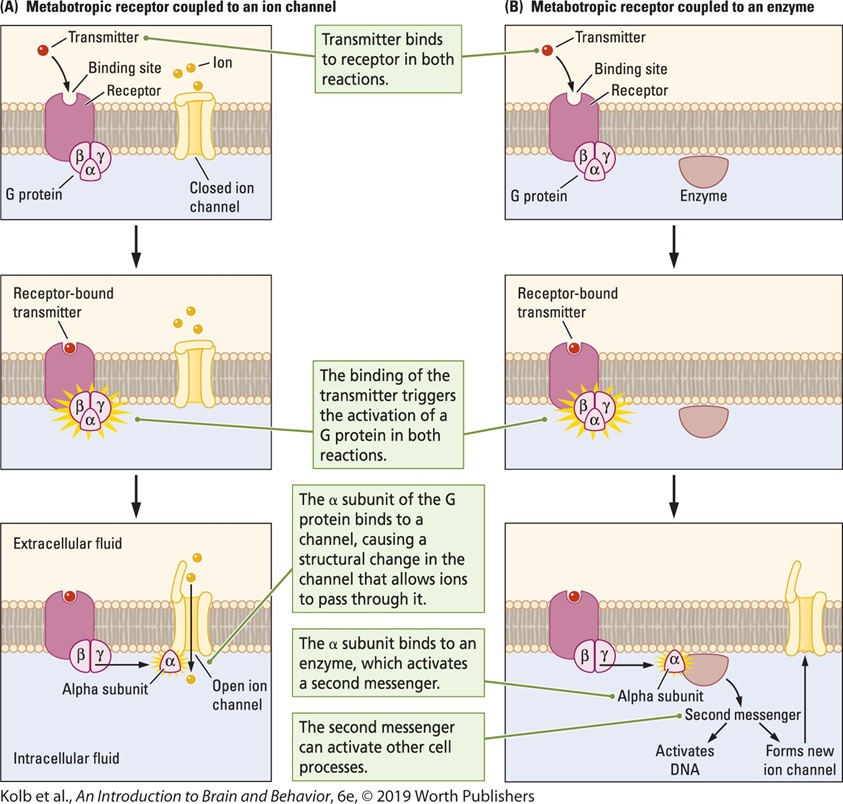
Second messenger
2 classes of receptors (metabotropic receptors)
______________ - detatched alpha subunit will binds to an enzyme— this enzyme turns into _________ — a chemical that starts a biochemical process when activated by a neurotransmitter (who are the first messenger)
______ can:
Bind to a channel & alter ion flow
Form new ion channels
Bind to DNA to alter protein production
Amplification cascade
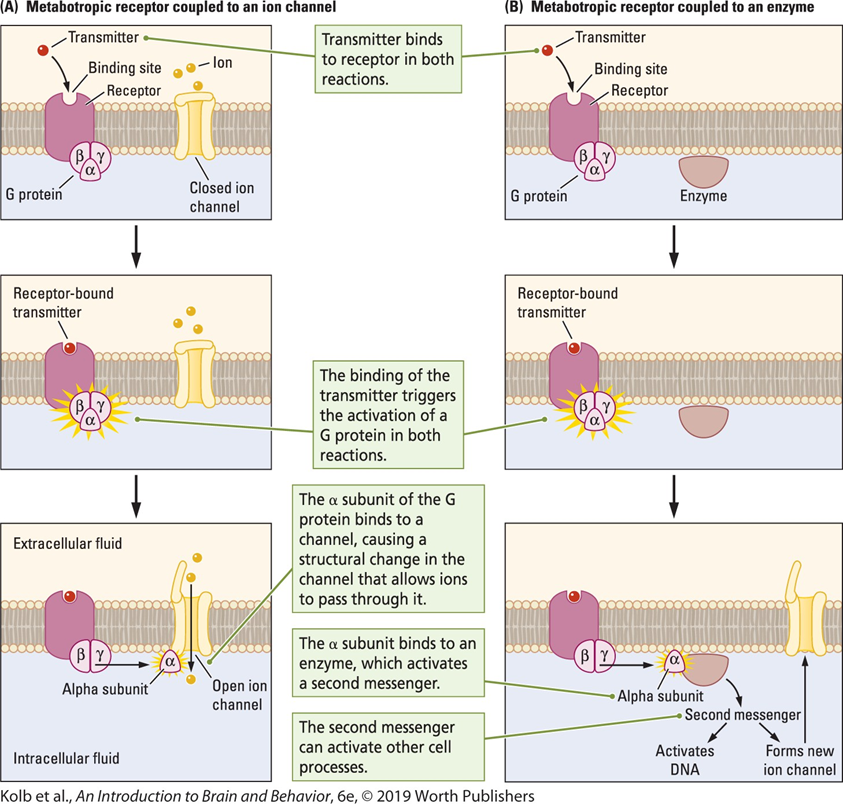
Subunits
2 classes of receptors (metabotropic receptors) - G protein
______________ - protein molecule that assembles w/ other protein molecules
For G-protein, these are alpha, beta, gamma
Amplification cascade
2 classes of receptors (metabotropic receptors) - G protein (second messenger)
______________ - metabotrpic receptors allow for the possibility that a single neurotransmitter’s binding can actiavte this—escalating sequence of events— a cascade effect in downstream proteins (second messengers or channels or both) being activated or deactivated
Creates a widespread amplifying effect, not seen in ionotropic receptors
Receptor subtypes
______________ - Each neurotransmitter may interact with a number of receptor subtypes specific to that neurotransmitter.
Each subtype has slightly different properties, which confer different activities.
Presence or absence of binding sites for other molecules, how long a channel remains open or closed, ability to interact with intracellular signaling molecules.
